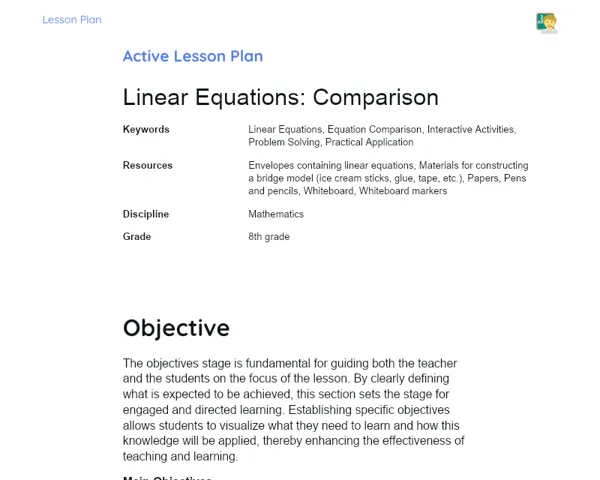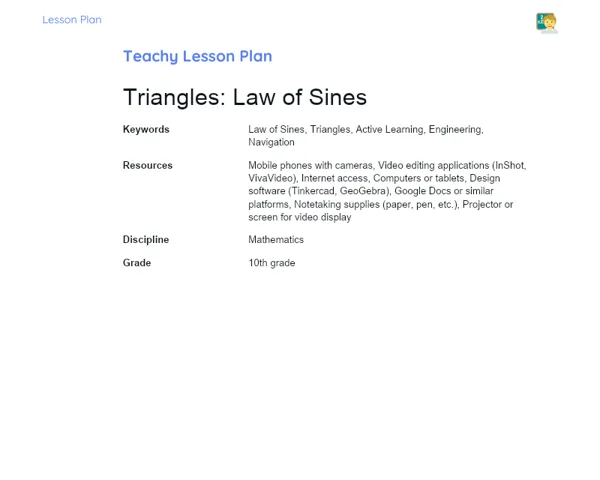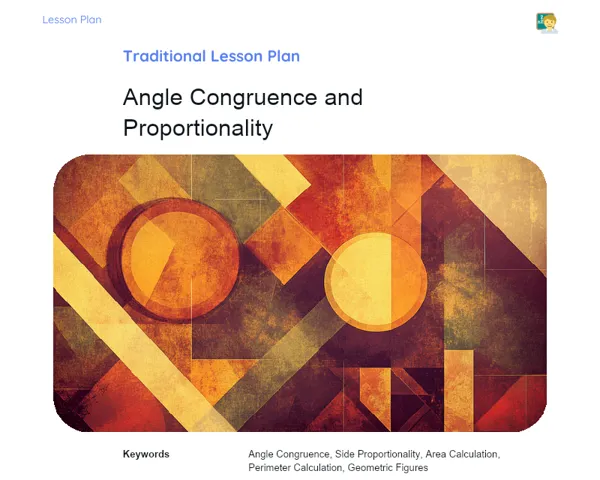Lesson Plan | Active Methodology | Rotations: Advanced
| Keywords | Rotations, Isometric transformations, Practical applications, Problem solving, Interactive activities, Critical thinking, Teamwork, Real context, Spatial visualization, Mathematics education |
| Necessary Materials | Geometric figures on colored cards, Paper, Scissors, Glue, Coordinate plane |
Premises: This Active Lesson Plan assumes: a 100-minute class duration, prior student study both with the Book and the beginning of Project development, and that only one activity (among the three suggested) will be chosen to be carried out during the class, as each activity is designed to take up a large part of the available time.
Objective
Duration: (5 - 10 minutes)
Setting clear objectives is essential for students to grasp what is expected of them in terms of learning and practical application during the class. By defining these objectives, teachers can focus students' attention on the critical elements of studying rotations, thereby ensuring effective and engaged learning. This approach optimizes the use of classroom time and encourages practical application of concepts they have previously learned at home.
Objective Utama:
1. Equip students with the skills to rotate figures and accurately articulate the results in a mathematically appropriate way.
2. Enhance their ability to pinpoint the coordinates of rotated figures on a plane, drawing connections to the concepts of isometric transformations (translation, reflection, rotation, and their combinations).
Objective Tambahan:
- Foster critical thinking and problem-solving skills via the manipulation of geometric figures in various configurations.
Introduction
Duration: (15 - 20 minutes)
The introduction aims to engage students with the material they reviewed at home through problem situations that encourage critical thinking about applying rotations in real-life scenarios. Further, the contextualization illustrates the topic's significance by showcasing how rotations are utilized across various fields, from art to technology, which can heighten student interest and understanding of the subject's importance.
Problem-Based Situation
1. Imagine you're tasked with designing a new board game using geometric shapes. How can you implement rotations to create exciting challenges for the players?
2. Think about a theatre production where the set needs to be quickly adjusted for various scenes. In what ways could rotations assist stage designers in streamlining this process?
Contextualization
Rotations are not simply an abstract mathematical concept; they hold significant importance in a plethora of practical applications, from industrial design to character animation in films and video games. For instance, when animating a character, artists rely on rotations to depict smooth and natural movements. Additionally, in the sphere of technology, rotations are employed in graphic algorithms to manipulate objects in three dimensions. Recognizing these applications can help students appreciate the real-world relevance of mathematical principles.
Development
Duration: (70 - 75 minutes)
The Development phase provides students with opportunities to dynamically apply the concepts of rotations and isometric transformations they studied at home. The activities aim to reinforce students’ understanding while promoting collaborative and active learning. Each task is designed to prompt students to think creatively and nurture problem-solving, communication, and teamwork skills.
Activity Suggestions
It is recommended that only one of the suggested activities be carried out
Activity 1 - The Dance of the Shapes Challenge
> Duration: (60 - 70 minutes)
- Objective: Put rotation knowledge into practice within a creative context, fostering the ability to visualize and manipulate shapes in space.
- Description: Students will be invited to create a choreography using geometric figures that, when rotated, will form an intriguing visual pattern. Each group will receive a collection of geometric shapes on colored cards and must devise a sequence of rotations that results in a visually captivating 'dance'.
- Instructions:
-
Divide the class into groups of up to 5 students.
-
Distribute a set of geometric figures (triangles, squares, circles) on colored cards to each group.
-
Instruct each group to plan a sequence of rotations for their assembled figures, ensuring they form an attractive pattern.
-
Groups should document their sequences of rotations and discuss the geometric properties involved.
-
Once prepared, each group will showcase their 'dance' of figures, executing the planned rotations.
Activity 2 - The Mystery of the Broken Mirror
> Duration: (60 - 70 minutes)
- Objective: Enhance spatial reasoning abilities and comprehension of isometric transformations through a fun and competitive exercise.
- Description: In this activity, students will unravel a 'mystery' involving several reflections and rotations on a plane to discover the final figure that will lead to the solution of the riddle posed by the teacher.
- Instructions:
-
Form groups of up to 5 students.
-
Provide each group with a collection of partially reflected or rotated geometric figures and a coordinate plane.
-
Groups must execute complementary rotations and reflections to reveal the 'hidden' figure.
-
Each correctly solved step will lead to a 'revelation point' where the group will receive a clue for the next step.
-
The first group to unveil the final figure wins a 'prize' for solving the mystery.
Activity 3 - Architects of Illusion
> Duration: (60 - 70 minutes)
- Objective: Investigate the properties of rotations and reflections to craft an optical illusion, integrating mathematical and artistic elements.
- Description: Students, working in groups, will be tasked with designing a simple architectural structure using paper and folding techniques. Isometric transformations will be applied to create an optical illusion, where the structure appears different from various angles.
- Instructions:
-
Organize students into groups of up to 5.
-
Provide each group with paper, scissors, and glue.
-
Guide groups to design and construct a structure that appears different from varying angles due to the applied rotations to the shapes.
-
Students should briefly describe the rotations used and the visual effects achieved in a report.
-
At the conclusion, each group will present their structure, detailing their rotation choices and the observed visual effects.
Feedback
Duration: (10 - 15 minutes)
This stage aims to reinforce learning by allowing students to articulate and reflect on the knowledge gained during the lesson. Group discussions not only deepen understanding of rotation and isometric transformations but also encourage communication skills and critical thinking. Additionally, this segment assists the teacher in assessing student understanding and identifying areas requiring further exploration.
Group Discussion
Conclude the lesson with a group discussion, during which each group shares their findings and experiences from the activities. The teacher should initiate this discussion with a brief introduction underscoring the significance of understanding rotations and isometric transformations, which are fundamental not only in mathematics but also across diverse practical applications. Encourage students to talk about the strategies they employed, challenges they encountered, and what they learned about applying rotation concepts in both real and creative contexts.
Key Questions
1. What were the main challenges you faced while applying rotations during today's activities?
2. How did you utilize isometric transformations to tackle the problems presented?
3. Were there instances where rotating a figure offered you a different perspective on it?
Conclusion
Duration: (5 - 10 minutes)
The conclusion phase ensures that students solidify the knowledge acquired during the lesson, summarizing key points and reinforcing the relation between theoretical studies and practical applications. Furthermore, it underlines the significance of rotation and isometric transformation concepts in the real world, inspiring students to view mathematics as a valuable and applicable tool across different situations.
Summary
In this lesson, we revisited the concepts of rotations and isometric transformations, examining how to apply these transformations to geometric figures to create patterns and resolve practical issues. Through hands-on tasks like 'The Dance of the Shapes Challenge', where students devised rotation sequences to craft attractive visual patterns, and 'The Mystery of the Broken Mirror', which invited them to uncover hidden figures using rotations and reflections, students engaged with the material in a practical and playful manner.
Theory Connection
Today’s lesson linked the theory of rotations and isometric transformations with practical applications, showcasing their importance across fields from pure mathematics to design, art, and technology. Engaging in practical activities enabled students to recognize the relevance of theoretical concepts in real life and the necessity of manipulating figures in space.
Closing
Grasping rotations and isometric transformations is vital not only for academic success in mathematics but also for real-world applications in daily life. The capability to visualize and manipulate figures in space, as well as to utilize these transformations in various contexts, is crucial for many professions, ranging from engineering and architecture to animation and game design. This lesson aimed not only to impart knowledge of concepts but also to emphasize their relevance and adaptability.



